När jag var i Borås i höstas fann jag ett vykort med en bild på ett krabbasnår med en mönsterbild som var den samma som på den ena gotlandsdynan. Men mindre. På framsidan kan man inte se någon skillnad mot min broderade dyna. Så – är den vävd eller broderad?
De två gotländska dynorna är broderade. Stygnen går huvudsakligen i varpriktningen och på några ställen går stygnen åt andra hållet. Så går det inte att väva! Dessutom börjar och slutar trådarna med knut, något man inte gör i vävning.
 Den vänstra bilden visar den dyna jag broderat (på orginalets framsida kan man inte urskilja något), den högra bilden är dynan på Textilmuseet.
Den vänstra bilden visar den dyna jag broderat (på orginalets framsida kan man inte urskilja något), den högra bilden är dynan på Textilmuseet.
The left photo is the cushion I have made (on the front of the original you can´t see anything), the right is the cushion in the Textile museum.
För ett par dagar sedan var jag på Textilmuseet och fick studera dynan där. Jag ville se baksidan.
 Vänster bild är orginalet från Gotland och till höger är dynan på Textilmuseet.
Vänster bild är orginalet från Gotland och till höger är dynan på Textilmuseet.
The left photo is the original from Gotland, and the right the one from Borås.
Det är stor skillnad! Krabbasnår väver man med avigsidan upp och där de olika färgerna möts kan man snärja dem om varandra. Så är det gjort på dynan i Borås. Det här är ett fragment utan stadkanter så man kan inte se om mönstret ligger i varpriktningen eller inslagsriktningen. Men det finns många dynor från trakten med samma mönster och de har mönstret liggande i inslagsriktningen. Dynan i Borås är vävd.
When I last autumn was in Borås I found a postcard in the museum – a “krabbasnår” with a pattern much like one of the cushions from Gotland. But smaller. On the front you can´t see a difference between the cushions. So – is the pattern woven or embroided?
The two cushions from Gotland are embroidered. The stiches are in the warp direction, but some are in the weft direction. You can´t weave this! And the threads starts and stops with knots, you don´t do that in weaving.
A couple of days ago I was in the museum and got the opportunity to study the cushion. I wanted to see the back side.
It is a big difference! You weave “krabbasnår” with the back side up in the loom and where the colour meet you can lay them round each other. You see it on the cushion to the right. This is a fragment so you can´t see in which direction the pattern threads are. But there are many cushions from the same region with the same pattern and there the pattern is in the weft direction. The cushion in the Borås museum is woven.
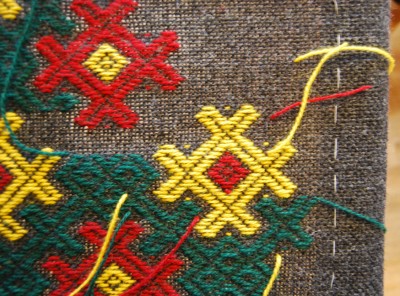 Jag ville göra ett försök att sy vävsömmen på ett ylletyg och därefter valka det hela. Jag vävde ett litet tygstycke med filtgarn, 4 tr/cm, och broderade med samma filtgarn. Efter tvätt valkades tyget i torktumlaren.
Jag ville göra ett försök att sy vävsömmen på ett ylletyg och därefter valka det hela. Jag vävde ett litet tygstycke med filtgarn, 4 tr/cm, och broderade med samma filtgarn. Efter tvätt valkades tyget i torktumlaren.  Skorna är sydda efter samma mönster som mina medeltidsskor. Sulan av
Skorna är sydda efter samma mönster som mina medeltidsskor. Sulan av



 Den vänstra bilden visar den dyna jag broderat (på orginalets framsida kan man inte urskilja något), den högra bilden är dynan på Textilmuseet.
Den vänstra bilden visar den dyna jag broderat (på orginalets framsida kan man inte urskilja något), den högra bilden är dynan på Textilmuseet. Vänster bild är orginalet från Gotland och till höger är dynan på Textilmuseet.
Vänster bild är orginalet från Gotland och till höger är dynan på Textilmuseet.

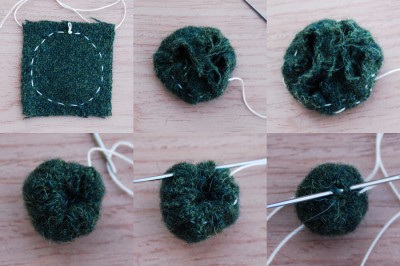
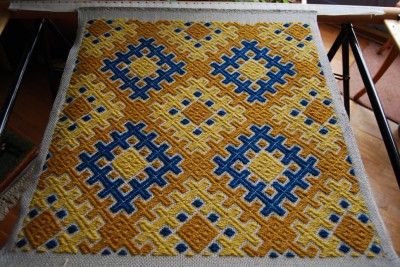
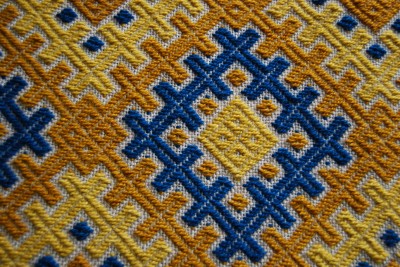
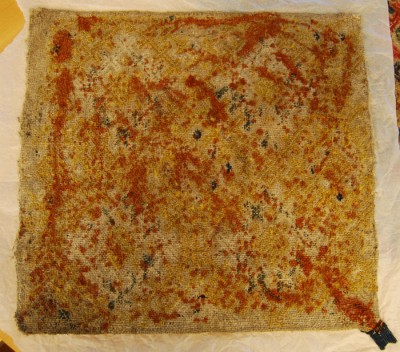
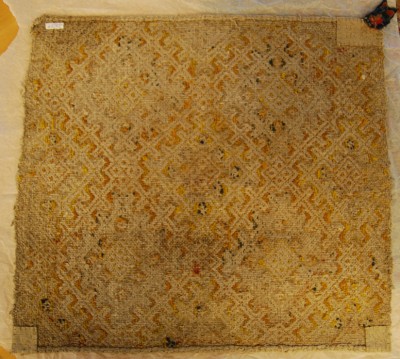 Vad jag kunde se så var det en gul färg och en blå, samma som på den första dynan. Men när jag på mina foton granskade baksidan för att se hur jag skulle brodera upptäckte jag att det nog var TVÅ gula färger. Tillbaka till museet och nu när jag fått upp ögonen så kunde jag tydligt se att en del partier var med en mörkare gul. Det syns enbart på baksidan.
Vad jag kunde se så var det en gul färg och en blå, samma som på den första dynan. Men när jag på mina foton granskade baksidan för att se hur jag skulle brodera upptäckte jag att det nog var TVÅ gula färger. Tillbaka till museet och nu när jag fått upp ögonen så kunde jag tydligt se att en del partier var med en mörkare gul. Det syns enbart på baksidan. Så en del av det gula garnet fick färgas över. Den första blev för mörk, men vacker. Den kunde vara färgad med bladen från valnöt. Den måste användas till något! Nästa såg ut att vara rätt och ett nytt besök på museet bekräftade det.
Så en del av det gula garnet fick färgas över. Den första blev för mörk, men vacker. Den kunde vara färgad med bladen från valnöt. Den måste användas till något! Nästa såg ut att vara rätt och ett nytt besök på museet bekräftade det. Ungefär så här kan dynan ha sett ut
Ungefär så här kan dynan ha sett ut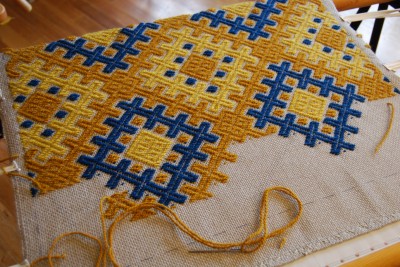
 Förra posten om dynan finns
Förra posten om dynan finns 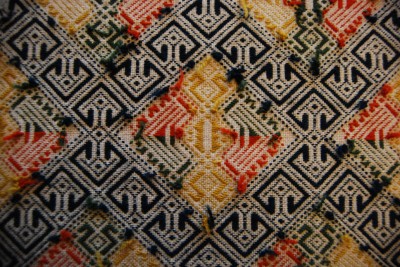 När jag såg knutarna kom jag ihåg vad jag lärde mig från en yrkesbordös. Hon beskrev hur man fäste trådar när man broderade i båge. Man kan ju inte vända en stor båge varje gång man ska fästa en tråd. Stick ner nålen genom tyget, snurra tråden runt nålen och dra igenom.
När jag såg knutarna kom jag ihåg vad jag lärde mig från en yrkesbordös. Hon beskrev hur man fäste trådar när man broderade i båge. Man kan ju inte vända en stor båge varje gång man ska fästa en tråd. Stick ner nålen genom tyget, snurra tråden runt nålen och dra igenom.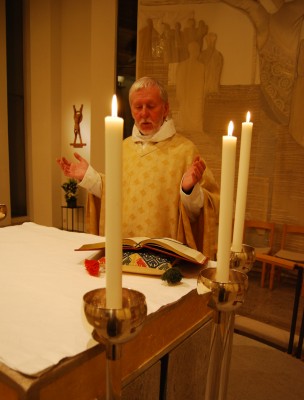
 The last post about the cushion is
The last post about the cushion is 